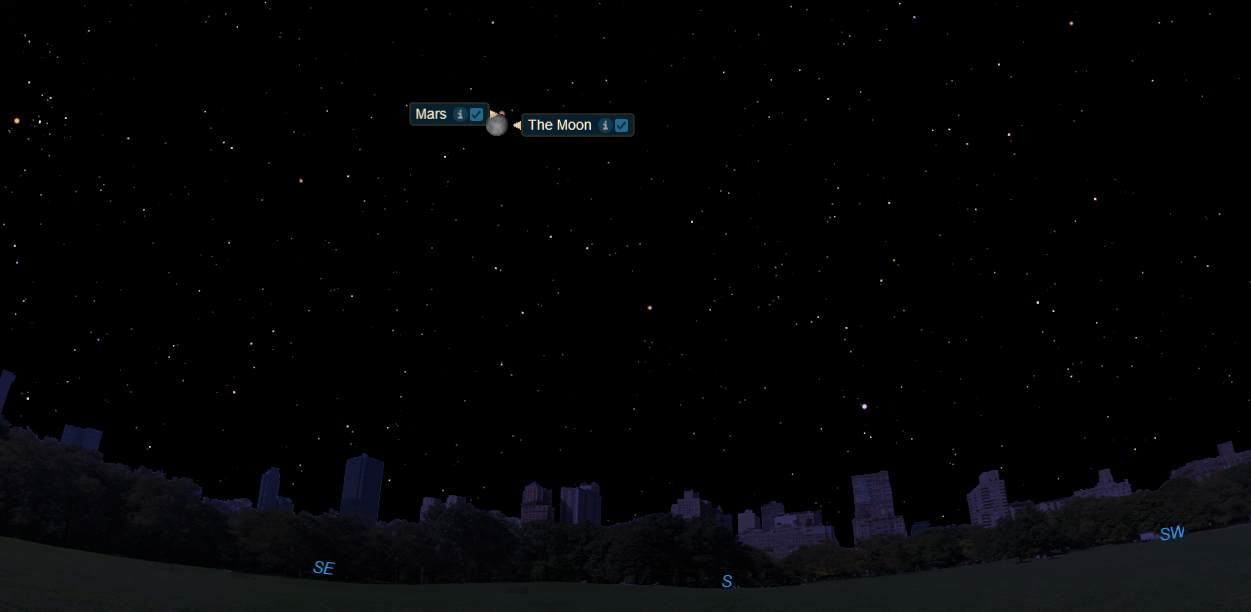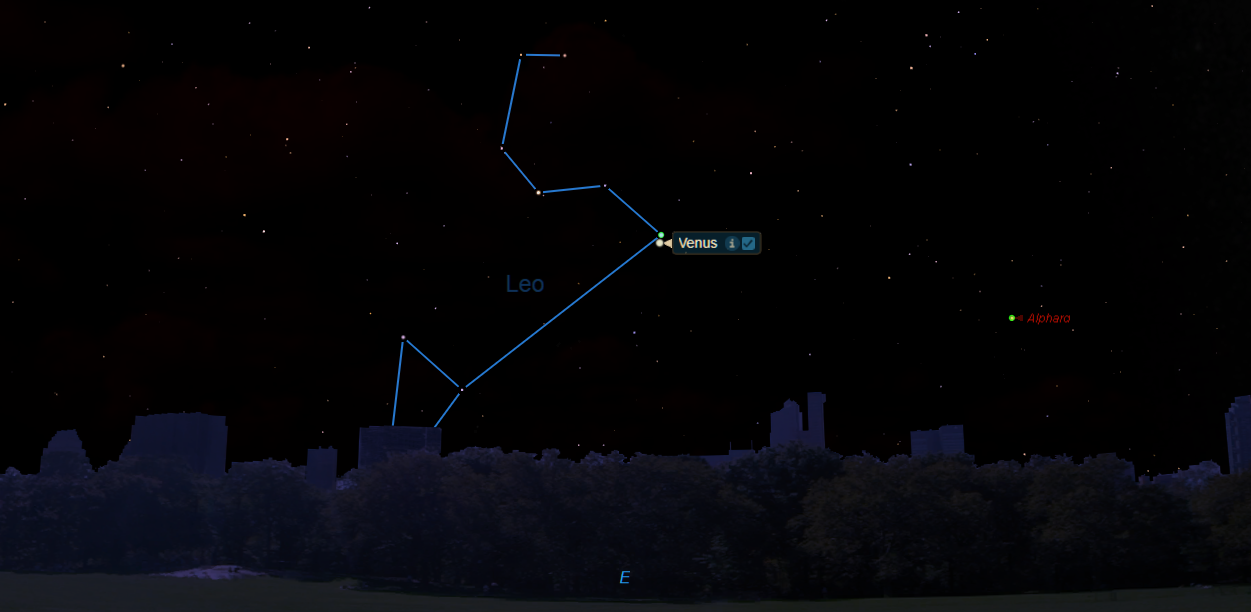
Friday night is date night for two bright celestial meetups that will light up the sky tonight (Oct. 2 - Oct. 3).
If skies are clear in your area during the overnight hours, you'll have an opportunity to see the nearly-full moon snuggling up with a shining Mars, followed some hours later by an even more brilliant Venus pairing off with one of the brightest stars in the sky.
The moon and Mars
On Friday night, Oct. 2, the moon, just one day past its "Harvest Full Moon" phase, will appear to glide closely above the planet Mars.
This dance will be a near facsimile of another close moon-Mars approach which took place less than a month ago on Sept. 5. That time, Mars and the moon approached each other a bit more closely than the upcoming rendezvous. But as if to compensate, this time Mars will appear twice as bright.
That's because Mars is only days away from making its closest approach to Earth on Oct. 6, while arriving at its best opposition until 2035 on Oct. 13. Both conditions mean the planet is now shining prominently with a dazzling yellow-orange glow.
Skywatchers located in Patagonia, the sparsely populated region at the southern end of South America, will actually see the moon hide Mars for a short time. (The International Occultation Times Association offers a map of visibility and more details about this "Mars eclipse." The same region will catch a total eclipse of the sun on Dec. 14.)
But if you aren't located in Patagonia, there's still plenty to see tonight. The close approach of Mars to the moon will be visible across the contiguous United States and southern Canada. The time of closest approach will come later in the evening as you head east.
Get the Space.com Newsletter
Breaking space news, the latest updates on rocket launches, skywatching events and more!
Depending on where you're located, moon and planet will be separated by 1.25 degrees to 1.5 degrees. Since the moon measures 0.5 degrees in width, you might assume that the gap between it and Mars will appear to be equal to three full moon widths. However, thanks to an optical illusion, the moon actually appears twice as large, making the gap seem much smaller.
If you live in the Pacific Time Zone, Mars and the moon will appear closest at around 8:20 p.m. For the Mountain Time Zone, the closest approach will come at about 9:35 p.m. Across the Central Time Zone, it's 11 p.m., while in the Eastern Time Zone the closest approach comes in the early hours of Saturday morning, at roughly 12:25 a.m.
The moon appears to move east in its orbit around the Earth at the rate of its own diameter each hour. This movement will be readily evident using Mars as a benchmark. From New York City, for example, when the moon and Mars appear very low over the eastern horizon at around 8 p.m., Mars will appear to the moon's upper left. But after midnight, Mars will appear to be hovering directly above the moon and by 6 a.m. on Saturday, Mars will appear to the moon's lower right as they descend across the west-southwest sky.
Two full moons?
Although Mars and the nearly full moon will appear side by side, don't fall for the ubiquitous internet hoax implying that Mars can seem to loom as large as the moon.
In tonight's tableau, Mars will be only 1.27% as large as the disk of the moon. So, to the naked eye it will appear not as a disk, but as a non-twinkling, albeit brilliant, "star."
No doubt many people who are out on the first Friday evening of October might do a double-take should they cast their gaze up toward the moon and wonder, "What is that fiery star that happens to be hovering above it?" But unless they're looking through the eyepiece of a telescope, nobody should expect to see Mars even remotely resembling a moon-size object.

Venus and the "Little King"
Early on Saturday morning we will be treated to another unusual sight, when Venus, the most brilliant planet, passes exceptionally close to Regulus, one of the brightest stars in the sky, located in the zodiacal constellation of Leo the Lion.
Regulus is the 21st brightest star in the sky and marks the heart of the Lion; the star's name is Latin for "Little King." Regulus is 79 light-years away and is actually not a single star, but a quadruple star system composed of two pairs of stars.
Venus is by far and away the brightest morning "star" and will remain the focal point of the eastern dawn sky through the autumn. Venus rises a bit more than three hours before sunrise, before even the first light of dawn.
In the days and weeks to come, early risers will take note of the fact that the sparkling planet will slowly move lower in the sky and fade slightly. But it is still positioned almost as well as it can be for any predawn apparition.
And on Saturday morning, Venus will be positioned just over half a degree to the south of Regulus. In the mornings that follow, the dazzling planet will move noticeably east of the star.
But spotting Regulus close to Venus on Saturday morning might initially be a bit of a challenge because of Venus's overpowering brilliance. Binoculars will be a great assistance, as Venus is now shining at magnitude -4.1 compared to bluish Regulus at magnitude +1.3. Converting this 5.4-magnitude difference into a ratio, we find that Regulus — one of the 21 brightest stars in the sky — shines only 0.6% as bright as Venus.
Joe Rao serves as an instructor and guest lecturer at New York's Hayden Planetarium. He writes about astronomy for Natural History magazine, the Farmers' Almanac and other publications. Follow us on Twitter @Spacedotcom and on Facebook.
Join our Space Forums to keep talking space on the latest missions, night sky and more! And if you have a news tip, correction or comment, let us know at: community@space.com.

Joe Rao is Space.com's skywatching columnist, as well as a veteran meteorologist and eclipse chaser who also serves as an instructor and guest lecturer at New York's Hayden Planetarium. He writes about astronomy for Natural History magazine, Sky & Telescope and other publications. Joe is an 8-time Emmy-nominated meteorologist who served the Putnam Valley region of New York for over 21 years. You can find him on Twitter and YouTube tracking lunar and solar eclipses, meteor showers and more. To find out Joe's latest project, visit him on Twitter.
-
rod FYI, you can see my comments on this celestial event here, https://forums.space.com/threads/antares-rocket-launches-new-astronaut-toilet-and-more-to-space-station-for-nasa.33891/Reply
Mars and the Moon about 1.5 degrees apart when I viewed was a great sight last night, and before, the Antares rocket launch observed too :)









